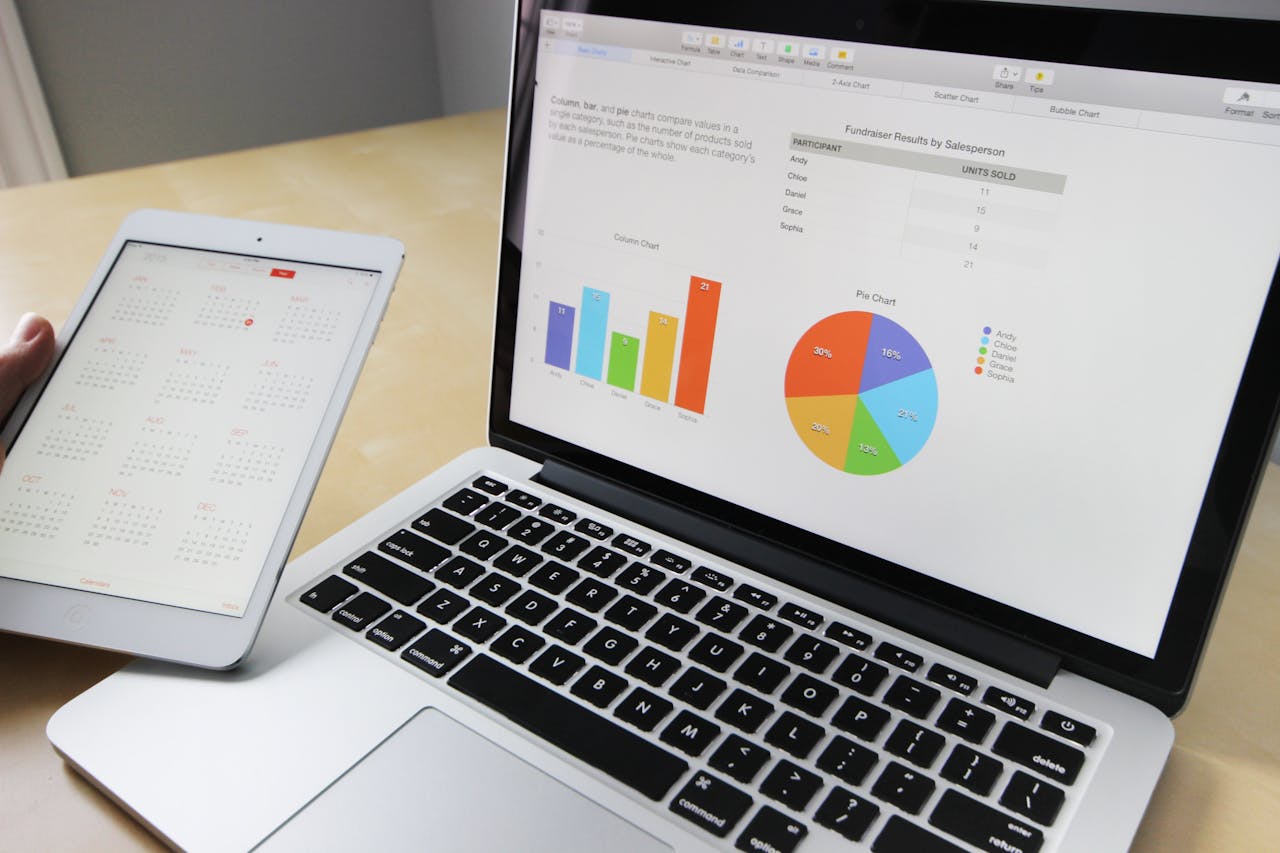When it comes to data analytics and business intelligence, having the right tools can make all the difference. Businesses today are inundated with vast amounts of data, and the key to extracting meaningful insights lies in effective data visualization. In this article, we will explore some of the top visualization tools available for business intelligence and how they can empower data-driven decision-making.
Key Takeaways:
- Data visualization is essential for businesses to make sense of their data and drive informed decision-making.
- There are various business intelligence tools available, each with its unique features and suitability for different types of businesses.
- Power BI integrates seamlessly with the Microsoft ecosystem, making it ideal for larger companies heavily reliant on Microsoft products.
- Chartio offers an affordable and user-friendly option for data visualization, with features like visual SQL and dynamic dashboards.
- Looker is known for its powerful data modeling capabilities, utilizing LookerML and providing a flexible approach to data analysis.
- Google Data Studio is a free and easy-to-use tool that integrates well with Google ecosystem products like Google Analytics and Google Sheets.
- Choosing the right visualization tool depends on the specific needs and objectives of the business, as different tools have varying strengths and weaknesses.
Power BI: Seamlessly integrate with Microsoft ecosystem
Power BI is a powerful business intelligence tool that offers seamless integration with the Microsoft ecosystem, making it an ideal choice for companies heavily reliant on Microsoft products such as Excel, Azure, and Access. Its integration capabilities enable smooth data flow between different platforms, ensuring efficient data analysis and visualization.
One of Power BI’s standout features is its support for Data Analysis Expressions (DAX). DAX is a formula language that allows users to create custom calculations, aggregation, and data modeling within Power BI. This advanced functionality enables businesses to perform complex calculations and derive meaningful insights from their data.
Power BI’s data modeling capabilities are robust, allowing users to create relationships between different tables and entities. This flexibility enables efficient and effective data exploration and analysis. Furthermore, Power BI offers a range of visualization options, including charts, graphs, and maps, which can be customized to showcase data in a visually engaging and understandable way.
However, it’s important to note that Power BI does have a steep learning curve, especially for users who are new to the platform. It may require expert knowledge to fully leverage its functionalities and set up data models effectively. Despite this, Power BI remains a popular choice for larger companies in the Microsoft ecosystem, thanks to its comprehensive features and seamless integration capabilities.
Chartio: Affordable and User-Friendly Data Visualization
When it comes to accessible and user-friendly data visualization, Chartio is a top contender in the business intelligence tool market. Known for its affordability and ease of use, Chartio caters to users of all skill levels, even those without coding experience.
Chartio’s strength lies in its commitment to making data accessible to anyone. With its intuitive interface and user-friendly features, users can easily explore and analyze data without the need for complex coding.
One of Chartio’s standout features is visual SQL, which allows users to query data without writing a single line of code. This empowers users to retrieve relevant information quickly and efficiently, maximizing productivity and eliminating the need for extensive data manipulation.
The platform also offers dynamic dashboards that automatically update based on user queries. This real-time functionality ensures that users have access to the most up-to-date information, enabling them to make informed decisions based on accurate and timely data.
While Chartio may not have all the advanced functionality that some other tools offer, its focus on data accessibility and user-friendliness makes it highly suitable for businesses of all sizes. Whether you’re a small startup or a large enterprise, Chartio provides an affordable and intuitive solution for your data visualization needs.

Quote
Chartio allows businesses to democratize their data by making it accessible to all stakeholders. Its intuitive interface and visual SQL feature enable users to uncover valuable insights without any coding knowledge.
Chartio also emphasizes collaboration, providing tools and features that promote seamless teamwork. Users can easily share dashboards, reports, and visualizations, fostering a collaborative environment where everyone can contribute to data-driven decision-making.
While some more advanced features may be missing, Chartio’s focus on affordability, accessibility, and collaboration make it a popular choice among businesses looking to harness the power of data visualization. With Chartio, you can unlock the full potential of your data and gain valuable insights to drive your business forward.
Looker: Powerful Data Modeling Capabilities
Looker is a robust business intelligence tool renowned for its powerful data modeling capabilities. With Looker, businesses can leverage advanced data modeling techniques to gain deep insights and make data-driven decisions. Looker employs LookerML, its proprietary data modeling language, which allows users to create customized and flexible data models tailored to their specific needs.
The ability to model data effectively is crucial for businesses to understand the complex relationships and patterns within their data. Looker’s data modeling capabilities enable users to define and structure their data in a way that facilitates efficient analysis and visualization. This empowers businesses to uncover valuable insights and identify trends that can drive strategic decision-making.
Looker also offers Looker Blocks, pre-built analytics code that can accelerate common data analysis workflows. These blocks provide a library of best practices and ready-to-use tools, saving time and effort. By utilizing Looker Blocks, users can jumpstart their data exploration and analysis, making it easier to derive meaningful insights in less time.
While Looker excels in data modeling and offers a wealth of features for data analysis, it is important to note that it may have limitations in terms of data manipulation and visualization compared to other tools. Nevertheless, Looker remains a popular choice for businesses seeking powerful data modeling capabilities that can transform raw data into actionable insights.
Google Data Studio: Free and easy integration with Google ecosystem
Google Data Studio is a highly versatile and cost-effective data visualization tool that seamlessly integrates with the Google ecosystem, including popular products like Google Analytics and Google Sheets. With its intuitive interface and robust set of features, Google Data Studio empowers users to transform raw data into meaningful visual insights for informed decision-making.
One of the key advantages of Google Data Studio is its seamless integration with various Google products. Users can easily connect their data sources, whether it’s website analytics, CRM data, or spreadsheets, and create dynamic visualizations that update in real-time. This integration enables businesses to leverage the power of their existing Google ecosystem and harness the full potential of their data.
In addition to its integration capabilities, Google Data Studio offers a wide range of reporting templates that cater to different industries and reporting needs. These templates provide a quick and easy way to visualize data and generate comprehensive reports. Users can also customize these templates to align with their brand identity and specific reporting requirements.
Google Data Studio’s drag-and-drop interface makes it accessible to users of all technical backgrounds. Whether you’re a data analyst, marketer, or business owner, you can easily create visually appealing dashboards and reports without the need for complex coding or programming skills. The intuitive nature of the tool speeds up the data visualization process, allowing users to focus on extracting meaningful insights from their data.
However, it’s important to note that Google Data Studio may have limitations in terms of third-party integrations and formatting options. While it seamlessly integrates with Google products, integration with external tools may require additional steps or workarounds. Formatting options may also be more limited compared to dedicated reporting software. Nonetheless, for users heavily reliant on the Google ecosystem, Google Data Studio offers an efficient and accessible solution for data visualization.
“Google Data Studio’s seamless integration with the Google ecosystem makes it an invaluable tool for businesses looking to unlock the power of their data. With its user-friendly interface and wide range of reporting templates, users can effortlessly transform complex data into clear visual insights.”
Overall, Google Data Studio is a free and user-friendly data visualization tool that empowers businesses to make informed decisions based on visual analytics. Its integration with the Google ecosystem, easy-to-use reporting templates, and intuitive interface make it a valuable asset for businesses of all sizes.
Conclusion
When it comes to data analytics and business intelligence, choosing the right visualization tools is essential for unlocking the full potential of your data and making data-driven decisions. The market offers a range of tools, each with its own strengths and weaknesses. Among the top contenders are Power BI, Chartio, Looker, and Google Data Studio.
Power BI stands out for its seamless integration with Microsoft’s ecosystem, making it an excellent choice for larger companies that heavily rely on Microsoft products. With features like Data Analysis Expressions (DAX) and strong data handling capabilities, Power BI empowers businesses to analyze and visualize their data effectively. However, it may require some expert knowledge to set up and fully utilize its capabilities.
Chartio, on the other hand, is an affordable and user-friendly data visualization tool. It focuses on making data accessible to everyone, even those without coding experience. With its visual SQL feature and dynamic dashboards that automatically update, Chartio offers a hassle-free experience. While it may lack advanced functionality, it caters to the needs of businesses of all sizes.
If data modeling is a priority for your business, Looker is a powerful option. Looker employs LookerML, a proprietary data modeling language, to provide a flexible and customized approach to data analysis. Looker’s pre-built analytics code, Looker Blocks, can also accelerate repetitive workflows. However, it may have limitations in data manipulation and visualization compared to other tools.
Lastly, Google Data Studio is a free tool that seamlessly integrates with other Google products, such as Google Analytics and Google Sheets. With its easy-to-use reporting templates and customizable visualizations, Google Data Studio is widely used and has a low barrier of entry. However, it may have limitations in third-party integrations and formatting options.
Ultimately, when selecting a visualization tool for your business, carefully evaluate your needs and objectives. Consider factors such as integration capabilities, ease of use, data modeling capabilities, and affordability. By choosing the right tools, you can harness the full potential of your data and gain valuable insights to drive informed decision-making.
FAQ
Why is choosing the right visualization tool important for business intelligence?
Choosing the right visualization tool is important for business intelligence because it enables businesses to unlock the power of their data and make data-driven decisions. Visualization tools allow businesses to analyze and interpret complex data in a visual format, making it easier to identify patterns, trends, and insights.
What is Power BI known for?
Power BI is known for its seamless integration with other Microsoft products like Excel, Azure, and Access. It is well-suited for larger companies that heavily rely on Microsoft’s ecosystem. Power BI offers features like DAX (Data Analysis Expressions) for data modeling and has strong data handling capabilities.
What are the strengths of Chartio?
Chartio is known for its affordability and ease of use, even for those with no coding experience. It offers features like visual SQL, which allows users to query data without coding, and dynamic dashboards that automatically update based on queries. Chartio is highly suitable for companies of all sizes looking for an affordable and user-friendly data visualization tool.
What are the data modeling capabilities of Looker?
Looker is known for its powerful data modeling capabilities. It uses LookerML, a proprietary data modeling language, to provide a flexible and customized approach to data analysis. Looker also offers pre-built analytics code called Looker Blocks, which can speed up repetitive workflows.
What are the advantages of using Google Data Studio?
Google Data Studio is a free data visualization tool that seamlessly integrates with other Google products like Google Analytics and Google Sheets. It offers easy-to-use reporting templates and allows users to create customized visualizations. While it has a low bar of entry and is widely used, it may have limitations in third-party integrations and formatting options.
How can businesses benefit from data visualization tools?
Data visualization tools allow businesses to transform raw data into meaningful insights. By visualizing data, businesses can easily identify trends, patterns, and correlations, enabling them to make data-driven decisions. Data visualization also enhances communication of data across teams and stakeholders, improving collaboration and understanding of complex information.
Source Links
- https://chartio.com/learn/business-intelligence/10-business-intelligence-tools-to-visualize-and-analyze-your-data/
- https://improvado.io/blog/the-best-data-visualization-tools-top-bi-software
- https://www.coursera.org/articles/bi-tools
- Regulatory and Compliance: Pioneering the Future of Saudi Arabia’s Dedicated Cargo Airline - December 21, 2024
- Financial Strategies: Fueling the Growth of Saudi Arabia’s Dedicated Cargo Airline - December 20, 2024
- Operational Excellence: Ensuring Competitive Edge for Saudi Arabia’s Dedicated Cargo Airline - December 19, 2024






